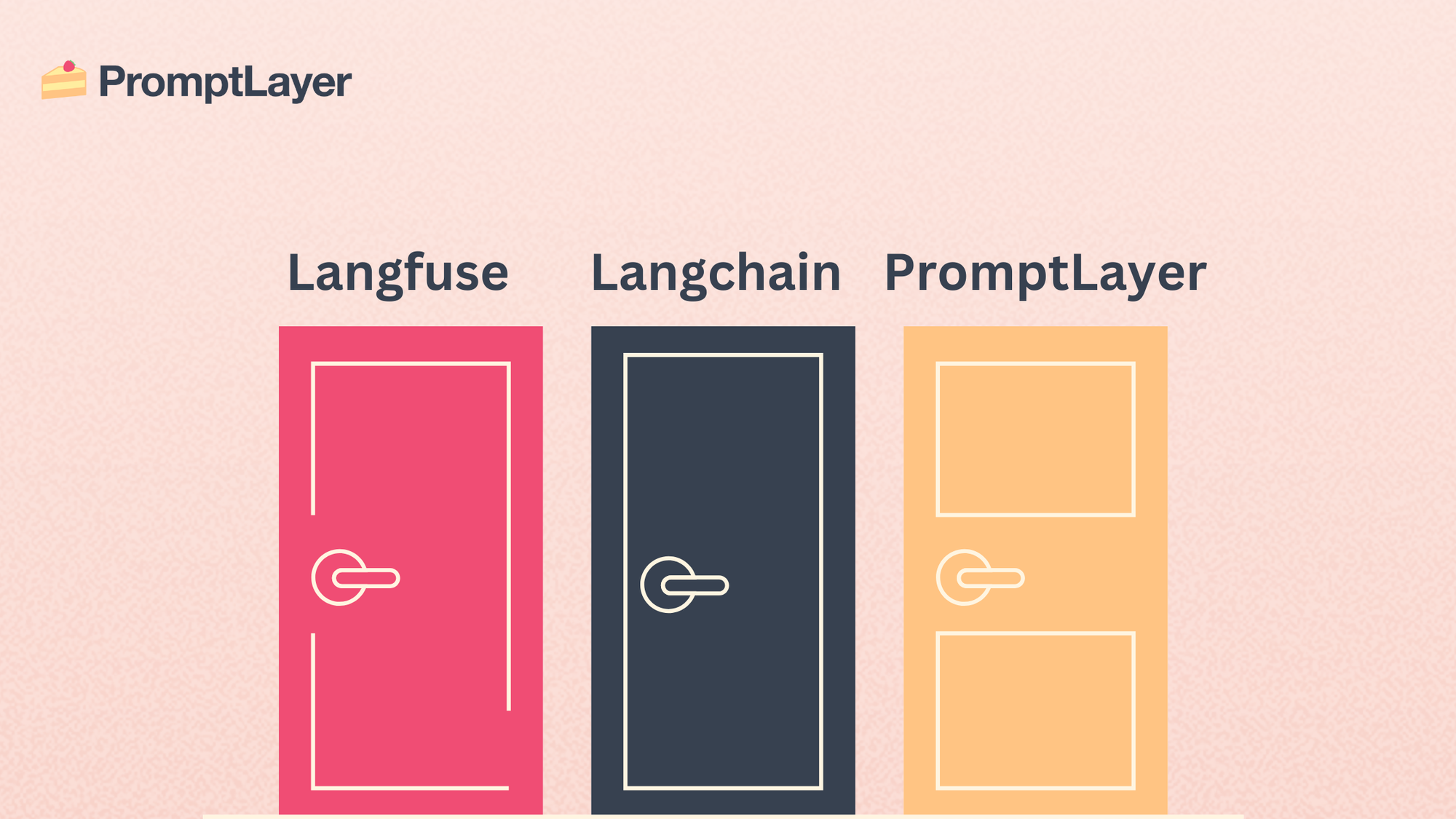Langfuse vs Langchain vs Promptlayer: Feature Comparison & Guide

It is a complex task to build, refine, and manage complex AI systems at scale. As LLM applications mature from early experiments to business-critical infrastructure, the selection of engineering platforms becomes pivotal—defining workflows, influencing innovation, and shaping cost and reliability. This is a direct, clear comparison of three top contenders: Langfuse, Langchain (with LangSmith), and Promptlayer.
Understanding the essentials: Langfuse, Langchain, and Promptlayer
Each platform addresses a distinct need in LLM development:
Langfuse gives developers precise control and transparent observability throughout the LLM application lifecycle. Open-source at its foundation, it meets the needs of teams seeking granular insight, robust debugging, and adaptable integrations.
Langchain empowers rapid construction of LLM-powered apps through flexible abstractions and a vast ecosystem. With LangSmith as a commercial companion, teams gain access to advanced monitoring, error analysis, and in-depth evaluation.
Promptlayer specializes in prompt engineering. It removes barriers between technical and non-technical collaborators, enabling direct management, testing, and optimization of prompts in a shared SaaS environment.
Want to try PromptLayer for free?
Feature-by-feature: how do they stack up?
Here’s how these solutions compare across categories that matter to teams building with LLMs.
1. Observability and tracing
Langfuse grants comprehensive, granular tracing for both LLM and non-LLM operations. Its compatibility with OpenTelemetry—a widely adopted standard for telemetry data—allows seamless integration with enterprise observability tools. The interactive interface accelerates debugging, even for intricate, multi-step flows.
Langchain, with LangSmith, reveals each step in agent and chain execution. For Langchain developers, LangSmith’s tracing, error analysis, and performance dashboards are deeply integrated, eliminating guesswork during troubleshooting.
Promptlayer directs its attention to the lifecycle of prompts and agent flows within its platform. Rather than whole-system introspection, it sharpens focus on the details that shape prompt performance and improvement.
2. Prompt management and collaboration
Langfuse puts versioning, rollbacks, and collaborative editing in reach for technical teams. While its console welcomes non-technical users to update prompts, the platform’s primary strengths remain developer-centric.
Langchain’s prompt management begins with basic templates. Teams needing a more organized approach find a Prompt Hub in LangSmith, though it lacks the rich, visual interface present elsewhere.
Promptlayer sets itself apart. Its visual registry, rigorous version control, robust A/B testing, and threaded feedback threads hand real control to domain experts—removing bottlenecks and accelerating iteration. No engineering intervention is required for prompt updates; marketing teams and product managers can lead.
3. Evaluation and analytics
Langfuse stands apart with an expansive evaluation suite: model-based assessments, human annotation, direct user feedback, and straightforward integrations with widely used evaluation libraries like OpenAI Evals and RAGAS. Dataset management tools enable teams to rigorously measure and compare performance.
Langchain (LangSmith) supports dataset creation and regression testing with a focus on agent and chain output quality. Performance analytics are built into the workflow, letting teams identify bottlenecks and optimize logic.
Promptlayer enables systematic prompt evaluation: batch testing, in-depth metrics for A/B comparisons, and assertion-based checks. Iterating on prompt versions with real user data is at the heart of the platform, ensuring quality keeps pace with production demands.
4. Openness, integration, and hosting flexibility
Langfuse is open-source under the MIT license, allowing teams to inspect, adapt, and deploy as they choose. Managed hosting and commercial features are available, but easy self-hosting and broad integration—from Langchain to OpenTelemetry—give developers freedom and transparency.
Langchain itself is open-source, yet key production tools like LangSmith and the LangGraph Platform are commercial and closed-source. Teams wishing to self-host LangSmith must obtain an enterprise license, placing some limits on control.
Promptlayer is commercial, closed-source, and exclusively cloud-based. There’s no option for self-hosting, but integrations with leading frameworks—Langchain, LiteLLM, LlamaIndex—ensure it fits into most existing LLM stacks.
5. Production readiness and scalability
Langfuse answers production requirements from the outset. Enterprise features such as Single Sign-On (SSO), role-based access, and compliance certifications ensure suitability for regulated environments. Tracing and metrics capabilities support confident scaling.
Langchain enables fast prototyping and production deployment, yet larger or more complex workloads may require extra engineering or dedicated MLOps support. LangSmith and LangGraph help address these challenges, but their commercial nature must be factored into planning.
Promptlayer’s ability to scale is proven in customer stories—handling millions of prompt executions where prompt management defines the bottleneck. Its reliability under load speaks to the platform’s maturity.
6. Target audience and ease of use
Langfuse attracts technical teams valuing depth and transparency. Its range of features demands a learning commitment but pays dividends for those who want full visibility and control.
Langchain draws developers and engineers eager to construct complex LLM workflows, with a vibrant community and extensive library of integrations.
Promptlayer reaches a wider spectrum—engineers, marketers, product managers, and legal teams. Its accessible interface invites cross-functional teams to shape prompt quality and adapt quickly, making it especially valuable for organizations where prompt expertise is distributed.
Feature comparison table
| Feature Category | Langfuse | Langchain (with LangSmith) | Promptlayer |
|---|---|---|---|
| Core focus | Open-source LLM engineering platform | Open-source dev framework + commercial MLOps platform | Commercial prompt engineering SaaS |
| Open source | Yes (core); commercial for some features | Framework: Yes; LangSmith: No | No |
| Self-hosting | Yes (FOSS/Enterprise) | LangSmith: Paid Enterprise License | No |
| Observability | Deep, OTEL-compatible, debugging UI | Agent/chain tracing, monitoring via LangSmith | Prompt/agent execution tracing |
| Prompt management | Versioning, rollbacks, collaborative UI | Prompt templates (basic); Prompt Hub (LangSmith) | Visual registry, A/B testing, blueprints |
| Evaluation | Model-based, human, integrations, datasets | Dataset creation, regression testing, RAGAS | Batch, A/B, assertion-based, analytics |
| Agent building | Works with Langchain/LangGraph | Powerful agents via LangGraph | Visual, no-code agent builder |
| Collaboration | Dev-centric; non-tech can manage prompts | Developer-focused, some SME features | Strong tech/non-tech collaboration |
| Pricing | Free (FOSS); Cloud: Hobby–Enterprise | Framework: Free; LangSmith: Freemium/Enterprise | Commercial SaaS (subscription/trial) |
Making the right choice: what matters most?
Every AI team brings a unique set of needs—some demand absolute control and observability, while others prioritize speed, collaboration, or scalability. The decision depends on your priorities:
Choose Langfuse for open-source transparency, granular oversight, and the flexibility to host and adapt as you see fit. Langfuse is ideal for teams who want a trustworthy, deeply integrated engineering platform and value long-term control.
Choose Langchain (with LangSmith) if you want to accelerate LLM app development with access to a massive community and a wide array of integrations. LangSmith unifies monitoring and evaluation, but note the commercial commitment.
Choose Promptlayer if prompt management and collaborative iteration are your core challenges. Here, non-technical stakeholders can shape LLM behavior directly, and fast A/B testing ensures you never lag behind user needs.
Many organizations combine these solutions—using Langchain for application logic, Langfuse for in-depth observability, and Promptlayer for prompt experimentation and deployment. This tailored approach can offer the best of all worlds, as long as integration and workflow discipline are maintained.
Conclusion
Choosing between Langfuse, Langchain (with LangSmith), and Promptlayer means weighing your team's specific needs for control, speed, and collaboration. Each excels in its area: Langfuse in engineering oversight, Langchain in rapid app development, and Promptlayer in collaborative prompt management.
About PromptLayer
PromptLayer is a prompt management system that helps you iterate on prompts faster — further speeding up the development cycle! Use their prompt CMS to update a prompt, run evaluations, and deploy it to production in minutes. Check them out here. 🍰



